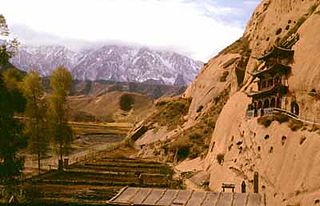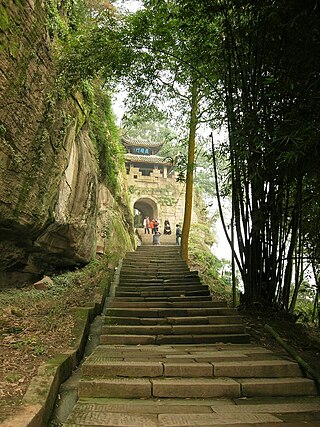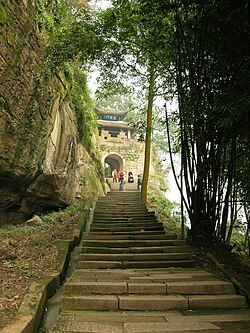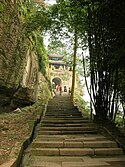
Sichuan is a province in Southwest China occupying most of the Sichuan Basin and the easternmost part of the Tibetan Plateau between the Jinsha River on the west, the Daba Mountains in the north and the Yungui Plateau to the south. Sichuan's capital city is Chengdu. The population of Sichuan stands at 83 million. Sichuan neighbors are Qinghai to the northwest, Gansu to the north, Shaanxi to the northeast, Chongqing to the east, Guizhou to the southeast, Yunnan to the south, and the Tibet Autonomous Region to the west.

Biligtü Khan, born Ayushiridara, also known by his temple name as the Emperor Zhaozong of Northern Yuan, was an emperor of the Northern Yuan dynasty, reigning from 1370 to 1378. He ascended to the throne after the death of his father Toghon Temür. In 1372, he defeated an invading Ming dynasty army and recaptured some regions that were previously lost to the newly founded Ming dynasty.

Uskhal Khan, also called the Last Lord of Northern Yuan or by his era name the Tianyuan Emperor, born Tögüs Temür, was an emperor of the Northern Yuan dynasty, reigning from 1378 to 1388. He was the last powerful khagan of the Mongols until Dayan Khan.

The Battle of Bun'ei, or Bun'ei Campaign, also known as the First Battle of Hakata Bay, was the first attempt by the Mongol-led Yuan dynasty of China to invade Japan. After conquering the Japanese settlements on Tsushima and Iki islands, Kublai Khan's fleet moved on to Japan proper and landed at Hakata Bay, a short distance from Kyūshū's administrative capital of Dazaifu. Despite the superior weapons and tactics of the Yuan forces, those that disembarked at Hakata Bay were grossly outnumbered by the samurai force; the Japanese had been preparing, mobilizing warriors and reinforcing defenses since they heard of the defeats at Tsushima and Iki. The Japanese defenders were aided by major storms which sunk a sizable portion of the Yuan fleets. Ultimately, the invasion attempt was decisively repulsed shortly after the initial landings.

The Battle of Kōan, also known as the Second Battle of Hakata Bay, was the second attempt by the Mongol-led Yuan dynasty of China to invade Japan after their failed attempt seven years earlier at the Battle of Bun'ei. In the summer of 1281, the Yuan invaded with two large armies. The Japanese defenders were aided by a major storm which sank a sizeable portion of the Yuan fleets. The invaders who reached the shore were repulsed shortly after landing. The Japanese called the opportune storm kamikaze, a name later used in the Second World War for pilots who carried out aerial suicide attacks.
Emperor Jingzong of Western Xia (1003–1048), born Li Yuanhao or Tuoba Yuanhao, also known as Zhao Yuanhao (趙元昊), Weiming Yuanhao (嵬名元昊) and Weiming Nangxiao (嵬名曩霄), was the founding emperor of the Western Xia dynasty of China, reigning from 1038 to 1048. He was the eldest son of the Tangut ruler Li Deming.

The Subei Mongol Autonomous County is an autonomous county within the prefecture-level city of Jiuquan in the northwest of Gansu Province, China, bordering Xinjiang to the west, Qinghai Province to the southeast and Mongolia's Govi-Altai Province to the north. Containing the northernmost point in Gansu, Subei is split into two non-contiguous sections and has an area of 66,748 km2 (25,772 sq mi) and had approximately 13,046 inhabitants in 2000. To the east it shares a border with Ejin Banner, Alxa League, Inner Mongolia.

Sichuanese or Szechwanese (simplified Chinese: 四川话; traditional Chinese: 四川話; Sichuanese Pinyin: Si4cuan1hua4; pinyin: Sìchuānhuà; Wade–Giles: Szŭ4-ch'uan1-hua4), also called Sichuanese/Szechwanese Mandarin (simplified Chinese: 四川官话; traditional Chinese: 四川官話; pinyin: Sìchuān Guānhuà), is a branch of Southwestern Mandarin spoken mainly in Sichuan and Chongqing, which was part of Sichuan Province until 1997, and the adjacent regions of their neighboring provinces, such as Hubei, Guizhou, Yunnan, Hunan and Shaanxi. Although "Sichuanese" is often synonymous with the Chengdu-Chongqing dialect, there is still a great amount of diversity among the Sichuanese dialects, some of which are mutually unintelligible with each other. In addition, because Sichuanese is the lingua franca in Sichuan, Chongqing and part of Tibet, it is also used by many Tibetan, Yi, Qiang and other ethnic minority groups as a second language.

The Diaoyucheng, or Diaoyu Fortress, is a fortress located on the Diaoyu Mountain in Heyang Town, Hechuan District, Chongqing. It is known for its resistance to the Mongol armies in the latter half of the Song dynasty.

Örüg Temür Khan, possibly Gulichi, (?–1408) was a khagan of the Northern Yuan dynasty, reigning from 1402 to 1408. Örüg Temür in historical materials compiled by the Timurid dynasty have been a descendant of Ögedei. Örüg Temür might also have been descended from either Ariq Böke or Genghis Khan's younger brothers, either Hasar or Temüge.

Jiange County is a county of Sichuan Province, China. It is under the administration of Guangyuan city. The history of Jiange County as a county division goes back around 1700 years. The county has historically been a junction between the north and south of Western China, through the Jianmen Pass. It is a popular tourist destination in Sichuan.

The Minjiang dialect is a branch of Sichuanese, spoken mainly in the Min River (Mínjiāng) valley or along the Yangtze in the southern and western parts of the Sichuan Basin in China. There is also a language island of the Minjiang dialect located in the center of the Sichuan Basin covering several counties, including all of Xichong, Yanting, and Shehong Counties, and part of Jiange, Cangxi, Nanbu, Langzhong and Bazhong. The Minjiang dialect is also referred to as the Nanlu dialect by some scholars.
Ba–Shu Chinese (Chinese: 巴蜀語; pinyin: Bāshǔyǔ; Wade–Giles: Ba1 Shu3 Yü3; Sichuanese Pinyin: Ba¹su²yu³; IPA:[pa˥su˨˩y˥˧]), or Old Sichuanese (or Old Szechwanese; Chinese: 蜀語), is an extinct Chinese language formerly spoken in what is now Sichuan and Chongqing, China.

The Sichuanese people are a Han Chinese subgroup comprising most of the population of China's Sichuan province and the Chongqing municipality.

The siege of Diaoyucheng, alternatively the siege of Diaoyu Castle, was a battle between the Southern Song dynasty and the Mongol Empire in 1259. It occurred at the Diaoyu Fortress in modern-day Hechuan District, Chongqing, China. Möngke Khan, the fourth khagan of the Mongol Empire, lost his life in this battle, making it the only battle where the Mongols lost their khagan during their campaigns of conquest. This battle was preceded by the siege of Baghdad in 1258. The siege of Diaoyucheng was a setback for the Mongol conquest.

The Liao dynasty was a Khitan-led dynasty of China that ruled over parts of Northern China, Manchuria, the Mongolian Plateau, northern Korean Peninsula, and what is modern-day Russian Far East from 916 until 1125 when it was conquered by the Jin dynasty. Remnants of the Liao court fled westward and created the Western Liao dynasty which in turn was annexed by the Mongol Empire in 1218.
Hu Zhaoxi was a Chinese historian who specialized in the history of Sichuan and the history of the Song dynasty. He was a professor at Sichuan University, where he served as Dean of the Graduate School, Director of the Sichuan University Library, and President of the Institute of Humanities and Social Sciences.

Bingqian, or Bingxingqian, is a term, which translates into English as "biscuit coins", "pie coins", or "cake coins", used by mainland Chinese and Taiwanese coin collectors to refer to cash coins with an extremely broad rim as, these cash coins can also be very thick. While the earliest versions of the Bingqian did not extraordinarily broad rims.

The debate on the "Chineseness" of the Yuan and Qing dynasties is concerned with whether the Mongol-led Yuan dynasty (1271–1368) and the Manchu-led Qing dynasty (1636–1912) can be considered "Chinese dynasties", and whether they were representative of "China" during the respective historical periods. The debate, albeit historiographical in nature, has political implications. Mainstream academia and successive governments of China, including the imperial governments of the Yuan and Qing dynasties, have maintained the view that they were "Chinese" and representative of "China". In short, the cause of the controversy stems from the dispute in interpreting the relationship between the two concepts of "Han Chinese" and "China", because although the Chinese government recognizes 56 ethnic groups in China and the Han have a more open view of the Yuan and Qing dynasties since Liang Qichao and other royalist reformers supported the Qing dynasty, the Han are China's main ethnic group. This means that there are many opinions that equate Han Chinese people with China and lead to criticism of the legitimacy of these two dynasties.


















